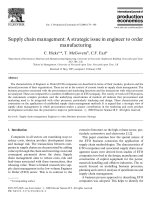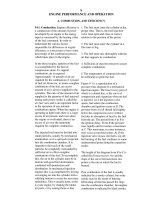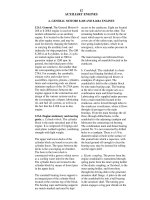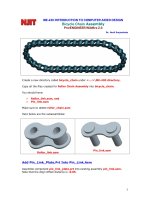Tài liệu Supply Chain Management docx
Bạn đang xem bản rút gọn của tài liệu. Xem và tải ngay bản đầy đủ của tài liệu tại đây (3.33 MB, 124 trang )
Supply Chain Management
Supply Chain Management
Chwen-Tzeng Su, PhD
Professor, Department of Industrial Management
National Yunlin University of Science & Technology
Touliu, Yunlin, Taiwan 640, R.O.C.
E-mail:
2
??
The Manufacturing Environment
The Manufacturing Environment
Global Market and Competition
Rapid Changes
?New products rapidly introduced
?Short, unknown product life cycles
High Variety of Products
Increasing storage and transportation costs
Difficult to forecast demand
3
??
Supply Chain Management Process
Supply Chain Management Process
Distribution Center
Plant
Customer
Supplier
• Multi - Organization
• Multi - Currency
• Global Consolidation
4
??
The Goals of the
The Goals of the
Manufacturing Organization
Manufacturing Organization
Responsiveness
Competitive pricing
Efficiency
Customer service
5
??
Why Do These Goals Conflict?
Why Do These Goals Conflict?
Forces for keeping low inventory
?inventory expensive
?low salvage values
Forces for keeping high inventory
?long lead times
?customer service is important
?demand is hard to predict
6
??
Definition:
“Supply Chain Management is primarily concerned
with the efficient integration of suppliers, factories,
warehouses and stores so that merchandise is
produced and distributed in the right quantities, to the
right locations and at the right time, and so as to
minimize total system cost subject to satisfying
service requirements.”
Supply Chain Management
Supply Chain Management
7
??
Suppliers
(International)
1.2 Million PC/Yr.
Glasgow U.K.
Warehouse
Port
PC Assembly
Plant
13 Transshipment
Points (TPs) in Europe
Country-wide
Distribution
Centers (DCs)
Retailers
Example of a Typical Supply Chain: IBM Europe PC Supply Chain
8
??
What Is the Goal of Supply Chain
What Is the Goal of Supply Chain
Management?
Management?
Supply chain management is concerned with the
efficient integration of suppliers, factories, warehouses
and stores so that merchandise is produced and
distributed:
?In the right quantities
?To the right locations
?At the right time
In order to
?Minimize total system cost
?Satisfy customer service requirements
9
??
Why SC Catches Attention?
Why SC Catches Attention?
Information technology revolution
Global competition in cost, quality, delivery, and cycle
time.
Emergence of inter-organizational relationship
10
??
Information Technology Revolution
Information Technology Revolution
In the not-too-distant past, the primary means of
communication between members of a supply chain
was paper.
One problem with paper-based systems has been the
time and money that is wasted re-keying the same
information into different computer systems.
As a result the growth of computers, which support
networks, and networks that support people’s needs
(business transactions, communication, etc.), has
exploded.
11
??
With Reduced Corporate Spending Increasing Revenue
is not an option.
Today: Difficult Economic Conditions
Today: Difficult Economic Conditions
With the Slowdown in
Customer Spending,
Increasing Sales or Prices
is not Easy.
Instead, Companies are
Concentrating on Cost
Reduction and Better
Customer Service.
12
??
Dynamics of Material Flow
Supplier
Plant Warehouse Logistics Retailer
13
??
Dynamics of Order Flow
Supplier
Plant Warehouse Logistics Retailer
14
??
Notice:
Notice:
Who is involved?
What level of activities are involved?
What do we mean by integration?
15
??
Supply Chain Planning Processes
Demand PlanningMaterial Requirement Planning
Demand Forecasting
Supplier Plant Warehouse Logistics
Retailer
Production
Plan
Component
Requirement
Order Management
16
??
A complex network
A complex network
–
–
example
example
National Semiconductors:
• Production:
– Produces chips in six different locations: four in the US, one
in Britain and one in Israel
– Chips are shipped to seven assembly locations in Southeast
Asia.
• Distribution
– The final product is shipped to hundreds of facilities all over
the world
– 20,000 different routes
– 12 different airlines are involved
– 95% of the products are delivered within 45 days
– 5% are delivered within 90 days.
17
??
GSCM at National Semiconductors
? Number, location and capacity of plants
? What product to build at which plant
?Number, location and capacity of DCs
? Which DC should serve which customer
? Number and location of repair centers
? Optimal design of spare parts
Manufacturing
Logistics
Spare Parts
? Decision Variables for GSCM
18
??
GSCM at National Semiconductors
? Which supplier to keep
? Which product to buy in a nation
? Which supplier should supply each plant
? Location & availability of cheap labor
? Export regulations, duty rates
Supplier Selection
Miscellaneous
19
??
? GSCM minimizes a weighted sum of total cost and activity days
1. Production Costs
2. Inventory Costs
3. Material Handling Costs
4. Taxes
5. Facility/Production Line Fixed Costs
6. Transportation Costs
7. Duty Costs
? Objective Function for GSCM
? Total cost includes
GSCM at Digital Equipment Corp.
20
??
? Customer demand is met for each product, in each period, in
each customer region
?Limits on number of facilities making each product
? Limit on number of facilities using each manufacturing style
?Fixed charges for products made by each facility
? Fixed charges for manufacturing style used by each facility
? Limited production capacity, inventory storage, and shipping
volume
? Constraints for GSCM
GSCM at Digital Equipment Corp.
21
??
Results
Companies that
utilized best-in-class
SCM solutions have
? Reduced inventory levels by 10-15%
? Reduced markdown & scrap by 10-15%
? Improved delivery reliability by 95-95%
? Used resources10-20% more efficiently
? Reduced transportation cost by 10-15%
? Reduced cycle time by 10-20%
22
??
Case: How Dell Reengineered
Case: How Dell Reengineered
its Supply Chain
its Supply Chain
Problem:
?Dell pioneered the mail order
approach to selling PCs
?In 1993, Compaq cuts prices to
drive Dell out of the market. Dell
experiences $65 million in losses.
23
??
Case: How Dell Reengineered
Case: How Dell Reengineered
its Supply Chain (cont.)
its Supply Chain (cont.)
Solution:
?Dell implements the following re-engineering
strategies:
?direct sell
?mass customization
?pull system
? Use of Information Technology
?provides suppliers with access to Dell’s inventories
?electronic orders & shipments
?e-collaboration with major buyers
?monitoring of productivity & returns on investments
24
??
Results:
? Classic case in supply chain management.
? In 2003, Dell made over $1 million in computer web sales/
day.
? Becomes leader in Customer Relationship Management
(CRM)
?Online tracking of orders & shipments
?Viewer approved configurations and pricing
? Customized home pages for clients.
? Increased communication with suppliers.
Case: How Dell Reengineered
Case: How Dell Reengineered
its Supply Chain (cont.)
its Supply Chain (cont.)
25
??
Lessons from the Case
Lessons from the Case
? By introducing a new business model , one can change
the manner in which business is done.
? To implement this model on a large scale, one needs to
build super supply chain management.
? Another major success factor in Dell’s plans was the
improvements made in its logistics system along the
entire supply chain.
? Improved communications and customer service, which
are part of Dell’s CRM program, are the cornerstones of
its success.
? Dell was using e-Commerce with its business partners.









